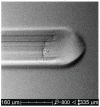Analysis of the Statistical Comparability of the Hardness and Wear of Polymeric Materials for Orthodontic Applications
- PMID: 34071606
- PMCID: PMC8197806
- DOI: 10.3390/ma14112925
Analysis of the Statistical Comparability of the Hardness and Wear of Polymeric Materials for Orthodontic Applications
Abstract
Background: Clinical success depends on the contact strength and wear resistance of medical devices made of polymer materials. The scientific goal resulted from the problem of using different methods of surface evaluation of materials used in the production of orthodontic appliances. The purpose of the work was an experimental comparative assessment of indentation hardness and scratch hardness and the sliding wear of four selected polymeric materials used in the manufacture of orthodontic appliances.
Methods: Four commercial materials were compared. Shore hardness tests and a scratch test with a Rockwell indenter were performed. A sliding wear test was performed using the ball-on-disc method. Statistical PCA and correlation analyses were performed.
Results: The results of scratch hardness measurements using a contact profilometer correlated with the Shore hardness to a greater extent than measurements made using an optical microscope. PCA showed that Shore hardness explains 45% of the total variance in all the results across the materials.
Conclusions: The scratch hardness method allows for a more explicit ranking of orthodontic polymeric materials when measurements are made with a profilometer. The ranking of sliding wear resistance should be made separately.
Keywords: dental biomaterials; microhardness; scratch resistance; sliding wear; thermocycling.
Conflict of interest statement
The authors declare no conflict of interest. The funders had no role in the design of the study; in the collection, analyses, or interpretation of data; in the writing of the manuscript; or in the decision to publish the results.
Figures



















Similar articles
-
Comparative Evaluation of the Tribological Properties of Polymer Materials with Similar Shore Hardness Working in Metal-Polymer Friction Systems.Materials (Basel). 2023 Jan 6;16(2):573. doi: 10.3390/ma16020573. Materials (Basel). 2023. PMID: 36676309 Free PMC article.
-
Hardness and Wear Resistance of Dental Biomedical Nanomaterials in a Humid Environment with Non-Stationary Temperatures.Materials (Basel). 2020 Mar 10;13(5):1255. doi: 10.3390/ma13051255. Materials (Basel). 2020. PMID: 32164254 Free PMC article.
-
The Effect of Thermocycling on Surface Layer Properties of Light Cured Polymer Matrix Ceramic Composites (PMCCs) Used in Sliding Friction Pair.Materials (Basel). 2019 Aug 29;12(17):2776. doi: 10.3390/ma12172776. Materials (Basel). 2019. PMID: 31470526 Free PMC article.
-
Academy of Dental Materials guidance-Resin composites: Part I-Mechanical properties.Dent Mater. 2017 Aug;33(8):880-894. doi: 10.1016/j.dental.2017.04.013. Epub 2017 May 31. Dent Mater. 2017. PMID: 28577893 Review.
-
Review of Novel High-Entropy Protective Materials: Wear, Irradiation, and Erosion Resistance Properties.Entropy (Basel). 2022 Dec 30;25(1):73. doi: 10.3390/e25010073. Entropy (Basel). 2022. PMID: 36673214 Free PMC article. Review.
Cited by
-
Assessment of Padding Elements Wear of Belt Conveyors Working in Combination of Rubber-Quartz-Metal Condition.Materials (Basel). 2021 Aug 2;14(15):4323. doi: 10.3390/ma14154323. Materials (Basel). 2021. PMID: 34361519 Free PMC article.
-
Energy Structure and Luminescence of CeF3 Crystals.Materials (Basel). 2021 Jul 29;14(15):4243. doi: 10.3390/ma14154243. Materials (Basel). 2021. PMID: 34361441 Free PMC article.
-
Comparative Evaluation of the Tribological Properties of Polymer Materials with Similar Shore Hardness Working in Metal-Polymer Friction Systems.Materials (Basel). 2023 Jan 6;16(2):573. doi: 10.3390/ma16020573. Materials (Basel). 2023. PMID: 36676309 Free PMC article.
-
Comparison of Surface Strains of Polymeric Frameworks for Fixed Implant-Supported Prostheses: A Digital Image Correlation Study.Materials (Basel). 2025 Apr 9;18(8):1700. doi: 10.3390/ma18081700. Materials (Basel). 2025. PMID: 40333280 Free PMC article.
-
Mechanical Properties of 3D Printed Orthodontic Retainers.Int J Environ Res Public Health. 2022 May 9;19(9):5775. doi: 10.3390/ijerph19095775. Int J Environ Res Public Health. 2022. PMID: 35565167 Free PMC article.
References
-
- Gómez-Mascaraque L.G., Palao-Suay R., Vázquez B. The use of smart polymers in medical devices for minimally invasive surgery, diagnosis, and other applications. In: Aguilar M.R., San Román J., editors. Woodhead Publishing in Materials, Smart Polymers and Their Applications. 2nd ed. Woodhead Publishing; Cambridge, UK: 2019. pp. 481–531.
-
- Lamprou D.A., Scoutaris N., Ross S.A., Douroumis D. Polymeric coatings and their fabrication for medical devices. In: Narayan R., editor. Encyclopedia of Biomedical Engineering. Elsevier; Cambridge, MA, USA: 2019. pp. 177–187.
-
- Shepherd D.E.T., Dearn K.D. Wear processes in polymer implants. In: Jenkins M., Stamboulis A., editors. Woodhead Publishing Series in Biomaterials, Durability and Reliability of Medical Polymers. Woodhead Publishing; Cambridge, UK: 2012. pp. 143–163.
LinkOut - more resources
Full Text Sources

